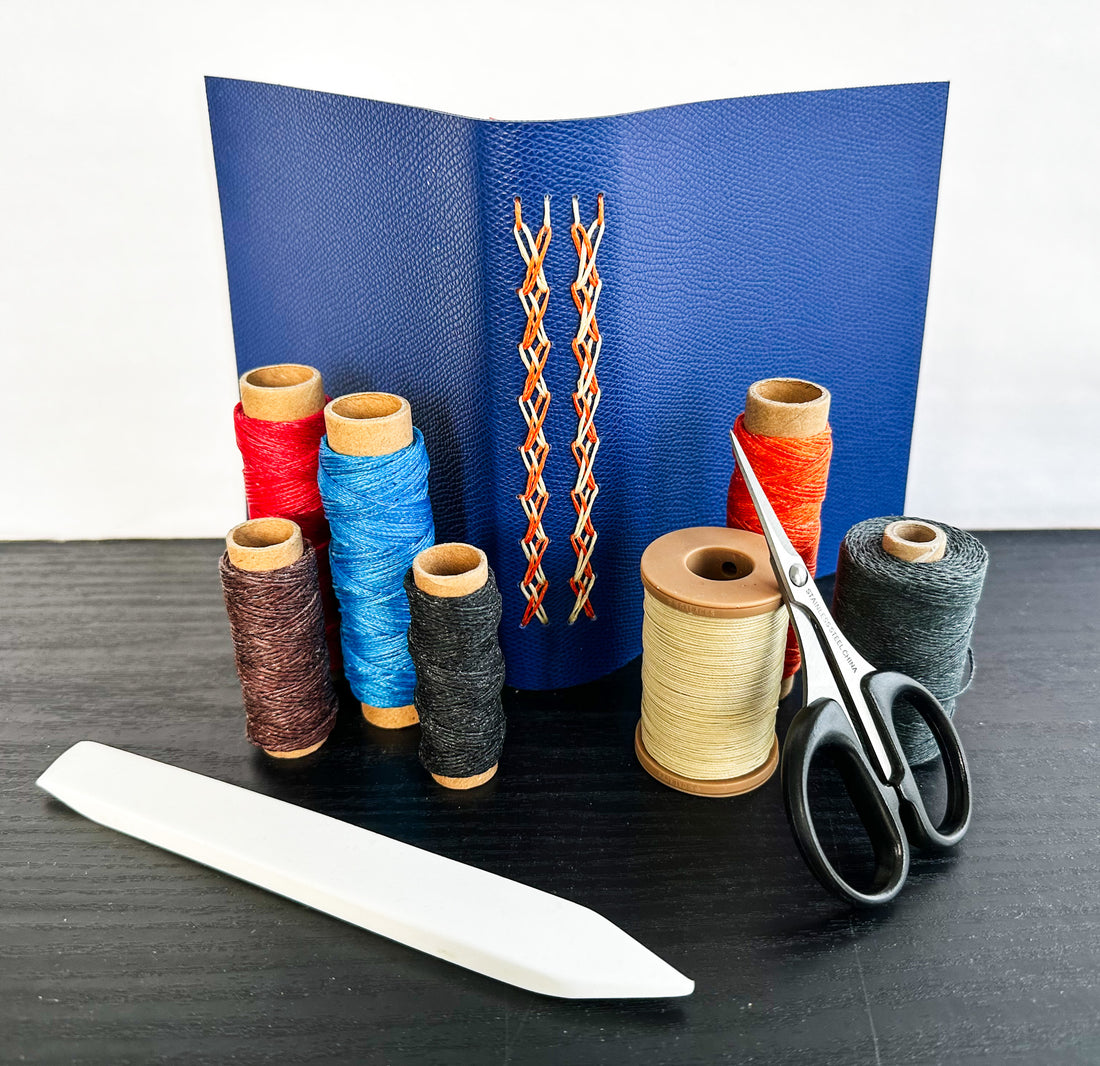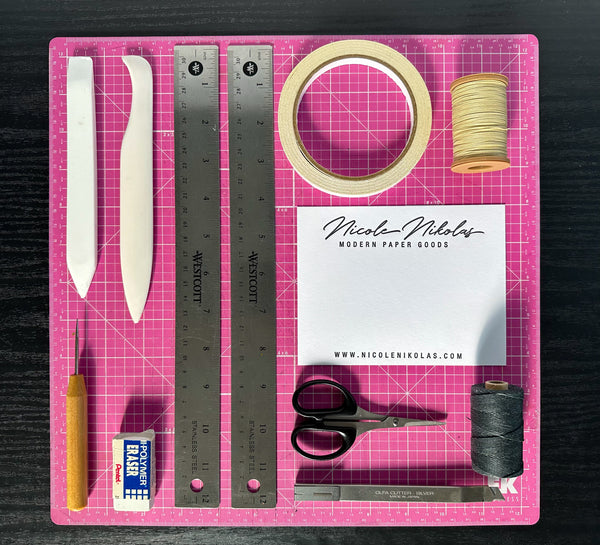
My Favorite Studio Tools
Share
Hello! Today I thought I'd share some of my favorite tools that are in constant use in my studio. A lot of these tools are universal for any creative studio and some are specialized for book binding. (All Amazon links are affiliate links. As an Amazon Associate, I due earn a small commission, but this does not effect your pricing.)
New to Book Binding?
Lineco make a great beginner kit that includes all the tools you need to get started with book binding, minus the paper. It features 2 awls, a bone folder, glue brush, 3 book binding needles, linen thread and beeswax. I use a lot of these exact tools from Lineco myself.
Quality Metal Rulers
I feel you need a ruler for every occasion and multiple of some sizes. I have two 12" metal rulers, one 18", one 24" and one 36". Why so many rulers? I don't like working with a ruler that is too long for the task. I like to swap them out based on the materials I'm working with. The 12" is the one I use the most and I have one for both my work tables. All but one is cork backed for non slippage and they are all Wesctott brand. I find something I like, I buy it in all colors and sizes.
Self-Healing Cutting Mats
I am always cutting papers for books or design projects. So, I cover my work surfaces with cutting mats. I have four mats in a variety of sizes from 8.5 x 11 to 24 x 36. Just like my rulers, I like a mat for each task. The first cutting mat I ever bought while in design school is the best one I own. It is still in great condition due to the quality and thickness. It is the Alvin brand of Professional mats.
Cutting Tools
My first choice for cutting is my X-Acto knife. I've owned mine since design school. Make sure to keep lots of extra blades in stock. My second choice is a new one for me; the Olfa knife. It's great for cutting thicker materials or stacks of paper. I also have a Fiskars Rotary cutter handy for fabric and leathers.
Scissors are also a must for some detail cuts and using with threads for book binding. I own a wide variety of scissors, sourced from a number of stores, which I don't have links to. But a good pair of scissors for paper, one for fabrics and another small pair for threads are a perfect starting point.
I would be remiss to not mention my guillotine cutter. It is a must for cutting down large stacks of paper or completed text blocks. It's definitely an investment, but well worth the money; in my opinion. My model is not longer produced, but this is the one I would purchase today if shopping for a new one.
HFS Stack Guillotine Cutter - 17"
Glues
Adhesives come in many forms and are all specific to the job at hand. I own way too many to list here, but here are a few of my most used:
Lineco PVA - For book binding projects
Elmer's Glue All - for craft projects in general
3M Permanent Glue Stick - for collage and crafting
Artist White Tape - great for holding paper in place without damaging them
Double Sided Tape - for any project where wet glue isn't necessary or needed

Bone Folders
Bone folders are an essential tool in book binding. I own two styles, a Teflon bone folder and a craft bone folder (It's Martha Stewart's brand and is sadly no longer in production). I love the craft one for the pointed edges that can be used for scoring, as well. The Teflon bone folder is great for not marring the papers.
Awls
Quality awls are necessary for successful book binding projects and I own my fair share. Lightweight to heavy duty, depending on the signatures weight.
Excel Aluminum Hobby Awl
C.S. Osborne Scratch Awl
Lineco Lightweight & Heavy Duty Awl (from the beginners kit listed above)
Last, but not least Threads
Threads are probably the most used and confusing part of book binding; besides short grain paper. There are so many choices of size, weight and materials. In general, the best quality book binding thread material is linen, waxed or unwaxed. If it's pre-waxed, that just saves you time. If it's not, just run beeswax over it a few times over it before you begin sewing.
I have used both linen, embroidery and synthetic threads. Linen is by far superior, but cheaper types are fine for beginners. However, if you are making a high quality book for longevity, use real linen threads.
Lineco Natural 5-ply linen thread, waxed - this is my go to thread for general book binding
Crawford Waxed Linen thread from Royalwood, Ltd - This is a top quality, linen thread for book binders, available in a variety of sizes and colors. If you have a color you love, it's cheaper to buy full spools. Their sample card is also a great resource to have.
Jupean Waxed Thread - I love using this with leather books or decorative book binding projects; where spine swell is not a concern. It is very strong.
Natural Ramie Rounded Wax Thread - This is great thin, but strong thread for case bound books; where spine swell may be an issue
That's it for this post. I do have a lot more gadgets than this. I'll save those for another day. Also, these are just items I use in my studio. Do your research and find what works best for you.
But, I know what you are thinking, what about paper? I covered that topic in an earlier blog post. Check it out here - Sourcing Short Grain Paper for Signatures. However, I'm testing some new papers, so I will be updating that blog post in the future.
Happy Book Binding!
P.S. As always, if you have any questions about any of the tools here or any not mentioned, comment below or on my contact page. I'll answer your questions as best as I can. Also, if you have a tool you can't live without, I want to hear about it!

2 comments
Thanks Shelia!
I do have an acrylic ruler as well. I can’t say that I’ve used it much in bookbinding, but I’ll have to give it a try. I usually cut with an Exacto or Olaf knife, so that’s why I prefer a metal ruler. But if you’re cutting through softer materials like paper, fabric or book cloth with a rotary cutter, I can see the advantages.It’s fun to hear how others work. We all pick up tips along the way.
Hi Nicole, I recently found your blog and shop and am learning so much. I just got into bookbinding after being a scrapbooker and quilter for years. Because of my quilting background, I wanted to share a link to an acrylic ruler. Once you use one you will love it. The advantage is you can line up the markings on the ruler to your cutting mat, even to the left or right of your cutting line. This ensures accuracy. You can even get them with lips that help hold it in place such as this one.
https://www.target.com/p/omnigrid-3-34-x-18-34-rectangle-quilting-ruler-with-removable-lip/-/A-84263447?sid=&ref=tgt_adv_xsp&AFID=google&fndsrc=tgtao&DFA=71700000012510727&CPNG=PLA_Storage%2BOrganization%2BShopping%7CStorage%2BOrganization_Ecomm_Home&adgroup=SC_Storage%2BOrganization_Garment+Care&LID=700000001170770pgs&LNM=PRODUCT_GROUP&network=g&device=c&location=9006733&targetid=pla-1460931296613&ds_rl=1246978&ds_rl=1247068&gad_source=1&gclid=Cj0KCQjw-mvBhDwARIsAA-Q0Q5EjzYOieuXHqtyUi6n_OdXuS1x8AH8yY4T3xZMnyCujAKOqd15HeoaAr9JEALwwcB&gclsrc=aw.ds
I find it so much easier to but board and cloth with this over a metal ruler.
Sheila